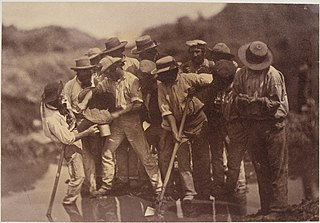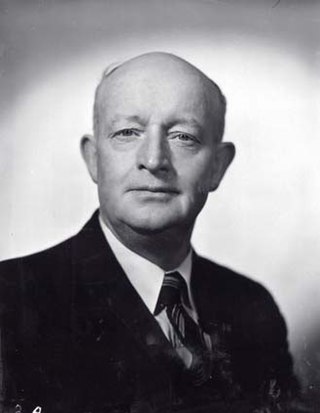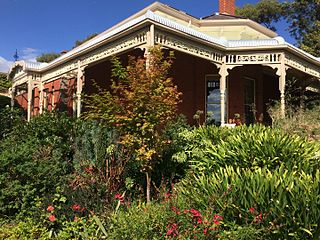Related Research Articles

Ballarat is a city in the Central Highlands of Victoria, Australia. At the 2021 Census, Ballarat had a population of 116,201, making it the third largest city in Victoria.

The Eureka Rebellion was a series of events involving gold miners who revolted against the British administration of the colony of Victoria, Australia during the Victorian gold rush. It culminated in the Battle of the Eureka Stockade, which took place on 3 December 1854 at Ballarat between the rebels and the colonial forces of Australia. The fighting resulted in an official total of 27 deaths and many injuries, the majority of casualties being rebels. There was a preceding period beginning in 1851 of peaceful demonstrations and civil disobedience on the Victorian goldfields. The miners had various grievances, chiefly the cost of mining permits and the officious way the system was enforced.

The Victorian gold rush was a period in the history of Victoria, Australia approximately between 1851 and the late 1860s. It led to a period of extreme prosperity for the Australian colony, and an influx of population growth and financial capital for Melbourne, which was dubbed "Marvellous Melbourne" as a result of the procurement of wealth.

Peter Fintan Lalor was an Irish-Australian rebel and, later, politician who rose to fame for his leading role in the Eureka Rebellion, an event identified with the "birth of democracy" in Australia.
The Midland Highway is a major rural highway linking major towns in Victoria, beginning from Geelong and winding through country Victoria in a large arc through the cities of Ballarat, Bendigo and Shepparton, eventually reaching Mansfield at the foothills of the Victorian Alps.

John Albert Leach was an ornithologist, teacher and headmaster in the state of Victoria, Australia.

Bernard Patrick O'Dowd was an Australian poet, activist, lawyer, and journalist. He worked for the Victorian colonial and state governments for almost 50 years, first as an assistant librarian at the Supreme Court in Melbourne, and later as a parliamentary draughtsman.

John Michael Mullens, was an Australian politician. He was an Australian Labor Party member of the Victorian Legislative Assembly from 1937 to 1945 (representing the seat of Footscray and an Australian Labor Party and then Australian Labor Party member of the Australian House of Representatives from 1949 to 1955.
Warrenheip is a suburb of Ballarat, Victoria, Australia on the eastern rural-urban fringe named after nearby Mount Warrenheip. At the 2021 census, Warrenheip had a population of 721.
James Robin was a prominent businessman in the early days of colonial South Australia. Several of his descendants were significant, in the Methodist Church and other fields. Also worthy of mention are his brothers Charles and Theophilus Robin.

Mancell Flo Kirby was an Australian harpsichordist, accompanist and music educator.
Samuel Fiddian M.A. was a schoolteacher, remembered as the first principal of Prince Alfred College in Adelaide, South Australia. He then founded a Grammar School in Creswick, Victoria, of which he was principal and proprietor from 1872 to 1903.

Trelawny is a gracious heritage house located at 804 Havelock Street, Black Hill, a suburb of the Victorian gold rush city of Ballarat, Victoria, Australia. Havelock Street, the street where Trelawny is located, was named in recognition of Major General Sir Henry Havelock, a British general who is particularly associated with India and the Indian Mutiny of 1857.
Ballarat Greyhounds or Morshead Park is a greyhound racing track located at Morshead Park, Sutton Street and Rubicon Street, Ballarat Central Victoria, Australia. Morshead Park is operated by the Ballarat Greyhound Racing Club (BGRC) and regulated by Greyhound Racing Victoria (GRV). It hosts the Ballarat Cup and has race distances over 390, 450, 545 and 650 metres. Racing is conducted Monday and Wednesday and occasional Saturdays and includes Tabcorp betting facilities and video replays broadcast on and off course.

Maude Edith Victoria Glover Fleay (1869–1965), was one of Australia's first wildlife artists. She was known for her paintings of Australian marsupials.
George Benjamin William Lewis commonly referred to as G. B. W. Lewis, or G. B. Lewis, was an English circus performer, later a circus and theatre entrepreneur in Australia.

John Rodger Greville was an Irish-born comic actor, singer, songwriter and stage manager who had a long career in Australia.

Mavis Louisa Freeman was an Australian bacteriologist and biochemist. She assisted Macfarlane Burnet in identifying the source of Q fever.
The South Street Society was an organisation based in Ballarat, Victoria, which conducted a series of performing arts contests and concerts originally styled the "South Street Competitions", which developed into the "Grand National Eisteddfod", later the Royal South Street Eisteddfod, not to be confused with the Ballarat Welsh Eisteddfods.
The Welsh Eisteddfods of Ballarat was a series of traditional eisteddfodau founded by Welsh miners at Ballarat in the gold rush days and revived in the early 20th-century by some of their descendants.
References
- ↑ "Ballarat College Speech Day". The Ballarat Star . Vol. XII, no. 303. Victoria, Australia. 20 December 1867. p. 2. Retrieved 19 November 2022– via National Library of Australia.
- ↑ "Ballarat Collegiate and Grammar School". The Ballarat Star . Vol. XIII, no. 299. Victoria, Australia. 15 December 1868. p. 3. Retrieved 19 November 2022– via National Library of Australia.
- ↑ "News and Notes". The Ballarat Star . Vol. XIII, no. 86. Victoria, Australia. 9 April 1868. p. 2. Retrieved 19 November 2022– via National Library of Australia.
- 1 2 "News and Notes". The Ballarat Star . Vol. XIV, no. 118. Victoria, Australia. 19 May 1869. p. 2. Retrieved 19 November 2022– via National Library of Australia.
- ↑ "Alfred Hall". City of Ballarat. Retrieved 21 November 2022.
- ↑ "Advertising". The Ballarat Star . Vol. XIV, no. 134. Victoria, Australia. 7 June 1869. p. 3. Retrieved 19 November 2022– via National Library of Australia.
- ↑ "Advertising". The Ballarat Courier . No. 796. Victoria, Australia. 30 December 1869. p. 3. Retrieved 19 November 2022– via National Library of Australia.
- ↑ "Coming Home". The Argus (Melbourne) . No. 22, 027. Victoria, Australia. 3 March 1917. p. 7. Retrieved 20 November 2022– via National Library of Australia.
- 1 2 "Historic Ballarat school demolished". The Argus (Melbourne) . No. 31, 509. Victoria, Australia. 27 August 1947. p. 3. Retrieved 19 November 2022– via National Library of Australia.
- ↑ "Two New King's Counsel". The Argus (Melbourne) . No. 25, 739. Victoria, Australia. 8 February 1929. p. 7. Retrieved 19 November 2022– via National Library of Australia.
- 1 2 3 4 5 6 "The Passing Show". The Argus (Melbourne) . No. 28, 492. Victoria, Australia. 15 December 1937. p. 12. Retrieved 20 November 2022– via National Library of Australia.
- ↑ "Obituary Dr. C. Callister". The Age . No. 29, 467. Victoria, Australia. 6 October 1949. p. 2. Retrieved 19 November 2022– via National Library of Australia.
- ↑ "Obituary". The Age . No. 27079. Victoria, Australia. 31 January 1942. p. 3. Retrieved 19 November 2022– via National Library of Australia.
- ↑ "Death of Mr E. G. M. Gibson". The Argus (Melbourne) . No. 30, 643. Victoria, Australia. 13 November 1944. p. 5. Retrieved 19 November 2022– via National Library of Australia.
- ↑ "Magistrate's Death". The Argus (Melbourne) . No. 28, 620. Victoria, Australia. 16 May 1938. p. 2. Retrieved 19 November 2022– via National Library of Australia.
- ↑ "Engineer's Death". The Argus (Melbourne) . No. 29, 118. Victoria, Australia. 19 December 1939. p. 9. Retrieved 19 November 2022– via National Library of Australia.
- ↑ "Tribute to a School Master". The Ballarat Star . No. 15754. Victoria, Australia. 5 November 1906. p. 2. Retrieved 20 November 2022– via National Library of Australia.
- ↑ "Dean Puts In Claim to General Northcott". The Herald (Melbourne) . No. 21, 489. Victoria, Australia. 3 April 1946. p. 2. Retrieved 19 November 2022– via National Library of Australia.
- ↑ "Obituary". The Age . No. 30, 795. Victoria, Australia. 12 January 1954. p. 2. Retrieved 19 November 2022– via National Library of Australia.
- ↑ "Ex-judge dies, 88". The Argus (Melbourne) . No. 33, 293. Victoria, Australia. 19 May 1953. p. 7. Retrieved 19 November 2022– via National Library of Australia.
- ↑ "Unbeaten In 38 Years". Sporting Globe . No. 2000. Victoria, Australia. 20 August 1941. p. 10. Retrieved 19 November 2022– via National Library of Australia.